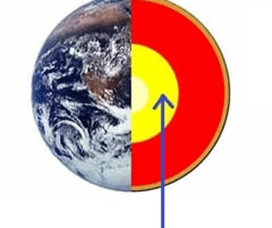type of electromagnetic radiation, and are useful in communications, radar and cooking
Deposition
When light falls on a shiny surface, it bounces back

CREST
All water on earth
HYDROSPHERE
a type of electromagnetic radiation. Best-known use for communication.
RADIO WAVE
Geological process in which earthen materials are worn away and transported by natural forces such as wind or water
EROSION
The bending of a wave as it passes at an angle from one medium to another.
REFRACTION
The part of Earth where life exists
- Layers of the atmosphere
- Biosphere
- Atmos
- Geo
 WHAT IS THIS ON THE EARTH'S LAYER?
WHAT IS THIS ON THE EARTH'S LAYER?
OUTER CORE
the number of waves that pass a fixed point in a given amount of time
WAVE FREQUENCY
Process of wearing or being worn by long exposure to the atmosphere
WEATHERING
a beam of light is redirected in many different directions when it interacts with a particle of matter.
SCATTERING
Rock that forms when magma cools and solidifies. Volcanoes erupt hot, liquid magma
The natural features of the land’s surface (mountains, hills, valleys, canyons)
- Hydro
- Groundwater
- Landforms
- Amos
the range of wavelengths that trigger brightness and colour perception in humans. It lies between UV and infrared radiation.
VISIBLE LIGHT
Particles of minerals,rock fragments, shells,leaves,bones, and other remains of things that were once alive
Sedimentary
 WHAT IS THIS CALLED?
WHAT IS THIS CALLED?
WAVELENGTH
COVID-19 is an example of a virus that can infect the human body. How does the COVID-19
virus differ from fungi?
A. Fungi are living organisms.
B. Fungi are not made of cells.
C. Fungi are non-living organisms.
D. Fungi are only made of one cell.
A. Fungi are living organisms.
A thin layer of gas surrounding Earth
- Atmosphere
- Groundwater
- Atmos
- Biosphere
Trough to trough
Crest to Crest
Plates rubbing against one another, the greater the friction, the greater the force or resulting earthquake
PLATE TECTONICS
Name 2 types of Waves
TRANSVERSE & LONGITUDINAL WAVES
the process by which water moves through the Earth and the atmosphere, organically and inorganically
WATER CYCLE
Which statement below distinguishes bacteria from a virus?
A. Both bacteria and viruses are nonliving and only cause disease in humans.
B. Both bacteria and viruses are living organisms that cause diseases in all living things.
C. Bacteria are nonliving, viruses are living organisms, and both can cause diseases in only
humans.
D. Bacteria are living organisms, viruses are nonliving, and both can cause diseases in all
living things.
D. Bacteria are living organisms, viruses are nonliving, and both can cause diseases in all
living things.